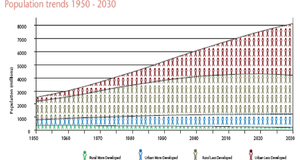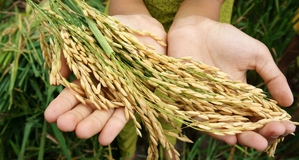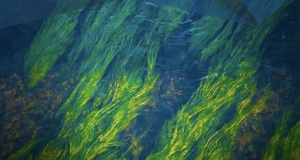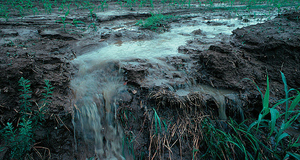From Earth Common Journal VOL. 3 NO. 2Selling Ourselves Short: A Discussion of Water-Markets in AlbertaDiscussionThe notion that water will be ever abundant has passed, and now society needs to begin making some difficult and complex decisions on where its values lie. The Water for Life strategy was first adopted in Alberta in 2004 and the government renewed the strategy for another 10 years starting in 2009. The document appears to be wellintended, although some of the wording is troubling. In discussing the “renewed” Water for Life strategy, the Government of Alberta (2009) indicated “five years later, Albertans continue to care about the health of the aquatic environment, as well as issues concerning water quality and quantity” (p. 3). That Albertans are still concerned about their water resources seems self-evident—there is no reason why this would change. Furthermore, “Water is an essential resource that must be protected to ensure future growth and prosperity in Alberta” (Government of Alberta, 2009, p. 3). The overriding concern for growth and prosperity suggests precedence over the more legitimate concerns of providing safe drinking water for municipalities and preserving the aquatic ecosystems. The Alberta Water Council recommended having the renewed strategy centralized around two key themes:
Some of the actions required to achieve these goals include addressing ecosystem degradation, determining best-practices, clarifying roles and responsibilities, enhancing data collection, and building shared commitments (p. 5). The report acknowledges that Alberta’s growth has created challenges for municipalities to provide safe drinking water and environmentally acceptable wastewater (p. 9). And yet the wording then appears to equivocate: under the heading of “Healthy aquatic ecosystems,” the stated goal is that “Albertans are assured that aquatic ecosystems are maintained and protected” (Government of Alberta, 2009, p. 12). Why is the goal not simply stated as “aquatic ecosystems are maintained and protected?” Such unclear wording creates confusion as to the government’s intent and actions regarding aquatic ecosystems. Are Alberta’s aquatic ecosystems really being “maintained and protected?” The Water for Life strategy is not very ambitious. One of the key actions is to “set water conservation objectives on all basins by 2015” (Government of Alberta, 2009, p. 13). The plan, in other words, is to have a plan by 2015. Another key action is to actually map out and model Alberta’s groundwater resources by 2015—interestingly, this task wasn’t completed decades ago. Under another heading,“Reliable, quality water supplies for a sustainable economy,” has the goal listed as “Albertans will be assured that water is managed effectively to support sustainable economic development” (Government of Alberta, 2009, p. 14). Once again, this goal could have been simplified to state “water will be sustainably managed.” But instead it is qualified in two ways:
These policies need to be rewritten to remove the ambiguity and give explicit direction on what actions are to be taken to promote conservation and true sustainability. There is misconception surrounding fresh water availability and renewal in Alberta. As taken from the Water for Life strategy, “our fluctuating water supply is challenging the way we allocate and use this renewable, but increasingly scarce, resource” (Government of Alberta, 2009, p. 20). Fresh water is not a renewable resource in the typical sense. The fresh water cycle functions within a closed system, and as such has a declining available water budget. Rain is the same water that had previously evaporated. Glacier melts will feed the provincial rivers and lakes, but these are finite (and dwindling) fresh water sources. In 2003, a Statistics Canada study, Human Activity and the Environment, warned that the country’s major glaciers, which hold 50% more water than the Great Lakes are melting quickly; approximately 1,300 glaciers have lost between 25% to 75% of their mass since 1950 (as cited in Barlow, 2007, p. 179). The fresh water we do have is being polluted through industry and careless actions. As reported by Barlow and Clarke (2002), even though Canada is a wealthy country, over one trillion litres of untreated sewage are still dumped into waterways every year (p. 31). The practice of dumping raw sewage into public waterways is more than an oversight: this is neglect on behalf of the Canadian people. The research process also uncovered a startling comment by Bakker (2007), stating “Canada is one of the few industrialized countries in the world not to have legally enforced water quality standards . . . The only serious federal law regarding water protection is the Fisheries Act, which prohibits dumping of materials in waterways that would harm aquatic life. But this act is routinely broken” (as cited in Barlow, 2007, pp. 184-85). Alberta and Canada, every place on Earth, needs strong government oversight to protect water resources. This study’s research methodology consisted of an extensive literary and historical review. The insights gained from this review will be discussed herein as they relate to Alberta’s specific situation. The objective is to identify policies and practices that will be sustainable for Alberta’s native ecology and communities. Sustainability has been criticized as a “highly idealized objective,” yet it provides important guiding principles, primarily by “setting priorities, providing a crucible to determine if decisions are likely to resolve conflicts by embracing solutions to several problems at once (or to exacerbate them by promoting one objective at the expense of all others” (Ostrom, 1990, and President’s Council on Sustainable Development, 1996, as cited in Feldman, 2007, p. 91). A market-based system of water allocation places profit ahead of protection. Conservation may be an argument for implementing water-markets; however, it alone is an insufficient reason for implementation considering the numerous case studies available like those reviewed earlier. One of the aims of the final key actions listed in the last pages of the Government of Alberta’s Water for Life strategy (2009) is to “Implement a market-based ecosystem services incentive program” by 2015 (p. 21). The phrasing is as ambiguous as ever, although it reads as though market-based water services are coming to Alberta by 2015. ResultsThe results of the research indicate that private ownership of water is a poor policy choice for Alberta. A special feature of Fortune magazine (May 2000) predicted the following: “Water promises to be to the 21st century what oil was to the 20th century: the precious commodity that determines the wealth of nations” (as cited in Barlow & Clarke, 2002, p. 104). With water quickly becoming such a valuable resource and regrettably a commodity as well, Alberta needs to implement meaningful policy changes to protect its water. Any assumptions that private ownership will automatically place water to its ‘highest and best’ use are dangerously flawed. Those with the ability to pay, like companies operating in the oil sands or corporations seeking a new source for bottled water, will always be able to outbid the individual households and farms that desperately need water but may be unable to afford it. Additionally, the argument that private enterprise will safeguard the ecosystem is equally flawed. Corporations have an unforgiving mandate to maximize share value; this can only be achieved by maximizing profit. Maximizing profits and externalizing costs does not bode well for aquatic ecology. Conclusions and RecommendationsPrivate ownership of a basic human necessity is carelessly short sighted. Short-sighted from the perspective of our sustainable development. Short-sighted in providing safe drinking water for our municipalities. And short-sighted in safeguarding our ecosystem from over-exploitation. After deliberating on the information available on the operation of water markets, the best policy framework for Alberta’s allocation system would include annual water lease licenses that would require strict government oversight, a progressive per-unit-rate based on conservation-orientated charging (for both municipal and industrial users), and by operating under a concessional-contract the financial burden to the municipality would be reduced while maintaining public ownership of the water. Stressing the necessity to enforce conservation-orientated charging for industrial users is important. The industrial users have traditionally consumed the bulk of our water resources and enjoyed limited accountability and lower utility rates. These practices must stop. As noted in the Water for Life Strategy, additional research is needed on the quantity of ground water contained in Alberta’s aquifers. Before the Province can begin to allocate anything, the policy makers need to know how much fresh water is actually available. As Alberta’s Provincial strategy indicates, we need water for life—let’s not sell ourselves short. AuthorDerek Neil Pluim is a student at MacEwan University, Bachelor of Communication Studies, and an active participant in the Edmonton environmental scene. He has volunteered extensively with the Edmonton Bicycle Commuters Society, the Federal Green Party, and the Edmonton Small Press Association. In addition to his volunteer work, Derek is a year-round cyclist, an avid hiker, and a mediocre poet. ReferencesAboriginal Affairs and Northern Affairs Development Canada (AANDC). (2013, January 13). Harper government announces major investment in First Nations water and wastewater systems. Retrieved from http://bit.ly/UWS1Rf. Barlow, M. Clarke, T. (2002). Blue gold: The fight to stop the corporate theft of the world’s water. New York, NY: The New Press. Barlow, M. (2007). Blue covenant: The global water crisis and the coming battle for the right to water. Toronto, ON: McClelland & Stewart. Calgary City Census. (2012, April 21). 2012 Civic Census Results. Retrieved from http://www.calgary.ca/CA/city-clerks/Pages/Election-and-information-services/Civic-Census/2012-Results.aspx. Barlow, M. (2012, June). Paying for water in a time of austerity and privatization: A discussion paper. Retrieved from http://www.canadians.org/water/documents/Water-Pricing-June2012.pdf. Canadian Union of Public Employees (CUPE). (2012, June 21). Water quality on Alberta’s First Nations unacceptable. Retrieved from http://bit.ly/PACa7I. City of Edmonton. (2012, April 1). Municipal Census Results. Retrieved from http://www.edmonton.ca/city_government/facts_figures/municipal-census-results.aspx. Feldman, D. L. (2007). Water policy for sustainable development. Baltimore, Maryland: The John Hopkins University Press. Garrick, D. Aylward, B. (2012). Transaction costs and institutional performance in market-based environmental water allocation. Land Economics, 88(3), 536-560. Government of Alberta. (2009). Water for life: Action plan. Edmonton, AB: Alberta Environment. Retrieved from http://environment.gov.ab.ca/info/library/8236.pdf. Holland, A. S. (2005). The water business: Corporations versus people. Black Point, NS: Fernwood Publishing Ltd. Janmaat, J. (2011). Water markets, licenses, and conservation: Some implications. Land Economics, 87(1), 145-160. doi: 10.1353/Ide.2011.0006. Rahman, N., Barlow, M., & Meera, K. (2011, May). Leaky exports: A portrait of the virtual water trade in Canada. Retrieved from http://canadians.org/water/documents/virtual-water-0511.pdf. Schwarz,C. (2013). Tailings pond image. Retrieved from http://bit.ly/19ZB2Yx. Thompson, D. Newman, K. (2009, December). Private gain or public interest: Reforming Canada’s oil and gas industry. Retrieved from http://parklandinstitute.ca/research/ summary/private_gain_or_public_interest/. Suggested Reading from Inquiries Journal
Inquiries Journal provides undergraduate and graduate students around the world a platform for the wide dissemination of academic work over a range of core disciplines. Representing the work of students from hundreds of institutions around the globe, Inquiries Journal's large database of academic articles is completely free. Learn more | Blog | Submit Latest in Environmental Studies |



















